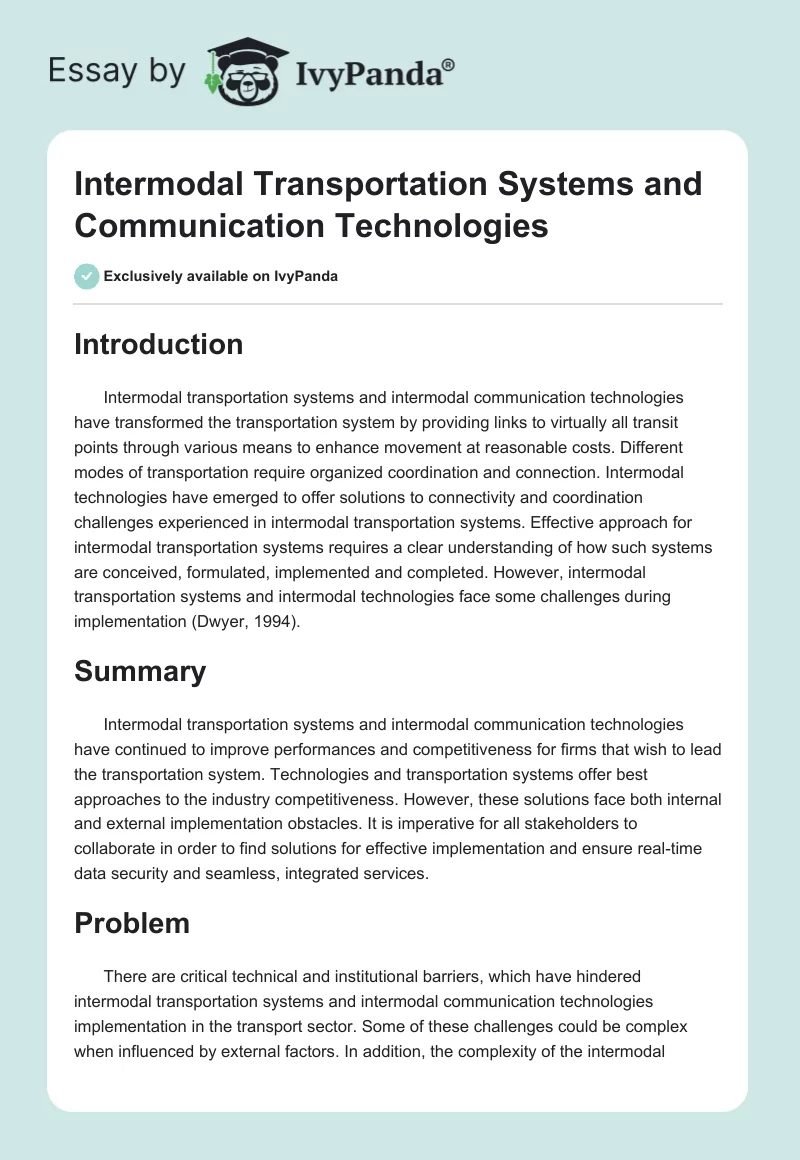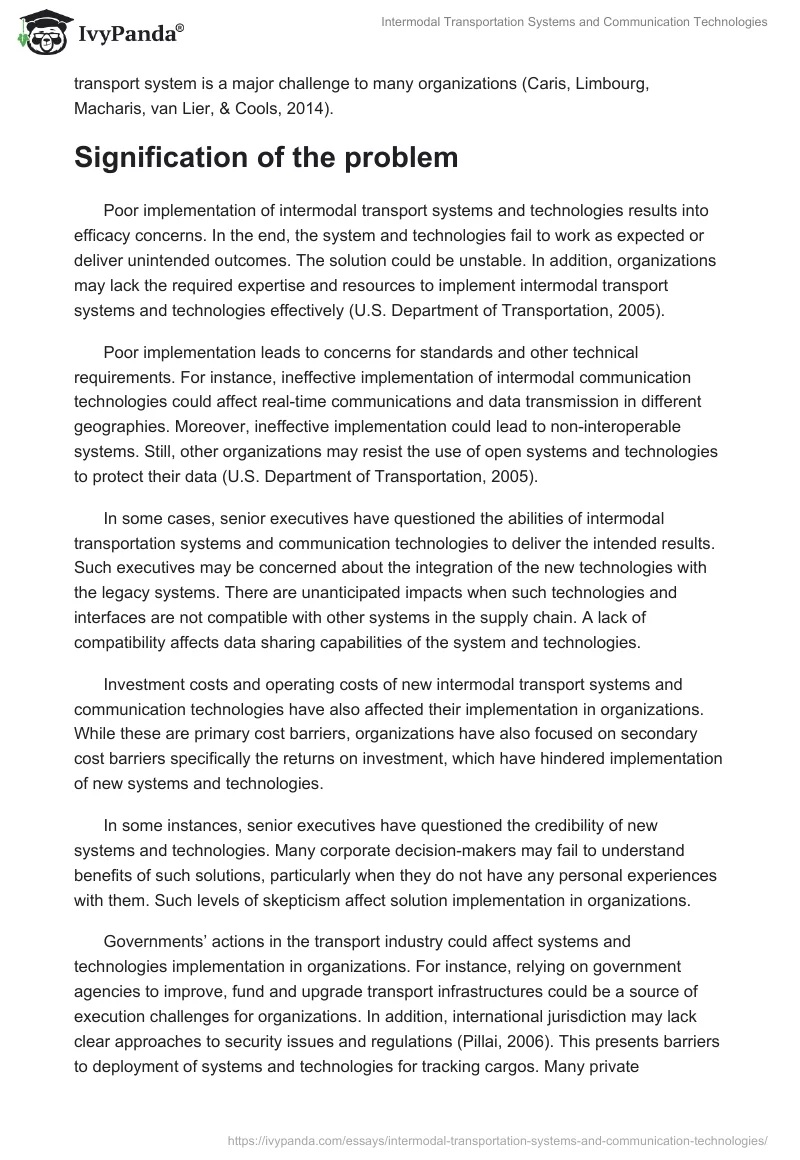Introduction
Intermodal transportation systems and intermodal communication technologies have transformed the transportation system by providing links to virtually all transit points through various means to enhance movement at reasonable costs. Different modes of transportation require organized coordination and connection. Intermodal technologies have emerged to offer solutions to connectivity and coordination challenges experienced in intermodal transportation systems. Effective approach for intermodal transportation systems requires a clear understanding of how such systems are conceived, formulated, implemented and completed. However, intermodal transportation systems and intermodal technologies face some challenges during implementation (Dwyer, 1994).
Summary
Intermodal transportation systems and intermodal communication technologies have continued to improve performances and competitiveness for firms that wish to lead the transportation system. Technologies and transportation systems offer best approaches to the industry competitiveness. However, these solutions face both internal and external implementation obstacles. It is imperative for all stakeholders to collaborate in order to find solutions for effective implementation and ensure real-time data security and seamless, integrated services.
Problem
There are critical technical and institutional barriers, which have hindered intermodal transportation systems and intermodal communication technologies implementation in the transport sector. Some of these challenges could be complex when influenced by external factors. In addition, the complexity of the intermodal transport system is a major challenge to many organizations (Caris, Limbourg, Macharis, van Lier, & Cools, 2014).
Signification of the problem
Poor implementation of intermodal transport systems and technologies results into efficacy concerns. In the end, the system and technologies fail to work as expected or deliver unintended outcomes. The solution could be unstable. In addition, organizations may lack the required expertise and resources to implement intermodal transport systems and technologies effectively (U.S. Department of Transportation, 2005).
Poor implementation leads to concerns for standards and other technical requirements. For instance, ineffective implementation of intermodal communication technologies could affect real-time communications and data transmission in different geographies. Moreover, ineffective implementation could lead to non-interoperable systems. Still, other organizations may resist the use of open systems and technologies to protect their data (U.S. Department of Transportation, 2005).
In some cases, senior executives have questioned the abilities of intermodal transportation systems and communication technologies to deliver the intended results. Such executives may be concerned about the integration of the new technologies with the legacy systems. There are unanticipated impacts when such technologies and interfaces are not compatible with other systems in the supply chain. A lack of compatibility affects data sharing capabilities of the system and technologies.
Investment costs and operating costs of new intermodal transport systems and communication technologies have also affected their implementation in organizations. While these are primary cost barriers, organizations have also focused on secondary cost barriers specifically the returns on investment, which have hindered implementation of new systems and technologies.
In some instances, senior executives have questioned the credibility of new systems and technologies. Many corporate decision-makers may fail to understand benefits of such solutions, particularly when they do not have any personal experiences with them. Such levels of skepticism affect solution implementation in organizations.
Governments’ actions in the transport industry could affect systems and technologies implementation in organizations. For instance, relying on government agencies to improve, fund and upgrade transport infrastructures could be a source of execution challenges for organizations. In addition, international jurisdiction may lack clear approaches to security issues and regulations (Pillai, 2006). This presents barriers to deployment of systems and technologies for tracking cargos. Many private organizations have raised their concerns about using open network systems when handling proprietary data. In such cases, inadvertent exposure of data in open systems and vulnerability of such systems and technologies affect implementation in such organizations.
Finally, employees may resist change in organizations. Consequently, they avoid the implementation of new systems and technologies due to expected training, possible loss of jobs or inability to operate new systems and technologies.
Organizations that wish to create competitive advantage have focused on adoption and implementation of systems and technologies to support their operations, but system and technology barriers could hinder their efforts.
Development of Alternate Action
System and technology security
Data security concerns, particularly in open systems remain a major challenge for many organizations. In addition, many jurisdictions have different laws on information security and data handling. Consequently, transportation system and communication technology integration has experienced drawbacks. Alternative solutions should ensure system computability through integrated platforms that support real-time data collection and reporting for effective decision-making. Moreover, alternative system and technology solutions must address threats and vulnerability to enhance implementation of such solutions.
Overcoming internal barriers
Organizations should handle internal barriers to intermodal system and technology implementation. For instance, they should have adequate senior management support and allocate resources to drive implementation processes. In addition, the complex nature of intermodal transportation requires system and technology developers to create secure, seamless solutions that can meet demands by global clients. Organizational innovations and technologies must continue to drive performance and competitiveness as they strive to overcome implementation barriers (Konings, 2008).
Recommendation
- Organizations should allocate adequate resources and secure senior executives’ support for system and technology implementation.
- There is a need for collaboration between stakeholders to provide effective solutions for the intermodal transportation.
- Effective implementation of intermodal transportation requires a multifaceted approach because of the complexity of the modes and the need for real-time data collection. In addition, technological and organizational innovations are critical in overcoming implementation barriers and improving performance and competitiveness of intermodal transportation systems.
References
Caris, A., Limbourg, S., Macharis, C., van Lier, T., & Cools, M. (2014). Integration of inland waterway transport in the intermodal supply chain: a taxonomy of research challenges. Journal of Transport Geography, 41, 126–136.
Dwyer, L. (1994). Intermodalism and ISTEA: The Challenges and the Changes. Public Roads, 58(2), 1.
Konings, J. (2008). The Future of Intermodal Freight Transport: Operations, Design and Policy: Transport Economics, Management and Policy Series. Northampton, MA: Edward Elgar Publishing.
Pillai, N. (2006). Key Issues and Challenges in Intermodal Transportation Security. Web.
U.S. Department of Transportation. (2005). The Freight Technology Story: Intelligent. Web.


